Right, so last night, I made up a batch of watercolor-tinted paper for collage and further paper-making projects. This idea stemmed from some accidental bleed-through that I got with watercolor markers on coffee filters and office paper and was reinforced by a section in Collage Unleashed by Traci Bautista that I ran across. All I used for this was household paper towels, Zig watercolor brush-markers and water. (Please note that using watercolor markers is probably the dumbest and most expensive way to do this -- squeezing a bit of tube watercolor -- though just a tiny bit, or painting from dry blocks would be more reasonable, but I was in a hurry...) Here's how I did it:
1) I allowed the watercolors to soak out of the brush-tips semi-randomly by wrapping the paper around and around the brush-tip and letting it sit with a weight (a bottle of gesso) on it for a few seconds or so. The towel paper is pretty efficient at sucking the pigment out of the pen so you don't want to leave it too long. You can see that I also added a blue line to one of the two sheets in a much more intentional effort. Also, for the two sheets that I worked on, I selected different pallets of pigment to use and the pens I chose for each are shown here with the "finished" sheets.
Once the pages were inked up, I wanted to transfer the pigment from sheet to sheet, spread it around on the sheets that I inked and also increase the number of sheets that I had to work with. There were places where the pigment was so heavy that it was obviously wet to the touch. To make this happen, I stacked two clean sheets of paper towel at the bottom, then one of the colored sheets, then three clean sheets, then the other colored sheet and finally two clean sheets at the top. Based on the results that you'll see below, I wish I'd placed more clean sheets, especially between the two.
At this point I moved from my paper-craft table downstairs to the kitchen counter upstairs since I'd be using water and leaving my work to dry under a ceiling fan. I wasn't sure about how (or how much) to wet the stack of towels but I was pretty sure that I didn't want to just run them under the faucet. I opted for a spray-bottle as the applicator. (And a pizza box to protect the counter -- but I should have put down newsprint instead of being lazy, now we have a bit of pink to our counter.)
I started out gingerly spritzing water onto the top. But a stack of nine paper towels is pretty absorbent and after going crazy with the sprayer for a while I discovered by pulling up a few sheets to look for saturation that it was all kind of floating at the top of the stack. This is what the top looked like after I was done with just spritzing the water. The problem with deciding that it needs more water is that the water-storage capacity of modern paper towels is astounding. Maybe I should have sprayed a bit on each towel as I layed them on the stack or something.
I ended up taking the lid of the sprayer and just pouring water onto the stack. And I got quite a bit too much, I think. I noted above that I wished I'd included more clean towels; that might still be good, but really, I should have used less water. Next time I'll pour it on more gradually and let it soak in before pouring the next bit on and try to reach a saturation without a soak. This is what the top looked like after I was done applying water.
So, once I had the stack soaking, I still noted that the migration of the pigments through the substrate was pretty minimal. And while there were some nice color combination blotchy areas, there was a bunch of plain white paper towel. As skeptical as one might be of using paper towels as an art medium anyway, plain white even makes me cringe. So I rolled the whole stack up thinking I could just knead the colors around -- which turned out to be correct.
The problem with kneading the colors around, at least in part, is that there was all that water trapped in the paper. When I squeezed, huge gushes of water would spill from the roll, carrying the pigment with it. You can see the mess that it was making below (but y'know, at least a mess of nicely colored paper towels is something I can use) where I was working. The real problem with all this water flow becomes evident when you note that after this step there is much less in the way of discrete color blotches. They've all bled together. Which is fine, but kind of less pretty than, especially, that first shot I took of the roll before I started squeezing. Again, less water next time.
So, after wringing the roll of towels out a bit, I unrolled them and picked them apart to spread and dry. All of the above-depicted work was done in half an hour on the evening of 01 Feb 2008 but these last two shots and some final drying are from the early morning of 02 Feb. You can see what I mean about the blotches bleeding together. I'm still not totally complaining about the effect, but more discrete colors might be nice too.
While I was flipping sheets and rearranging them so that they would dry more fully, I noticed lots of little details on many of the sheets. I wasn't really even looking for them, but even with (or maybe because of) the massive integration of the different pigments, a bunch of places where the colors did curious things formed. Of the few that I specifically noted, I particularly liked this one.
02 February 2008
Subscribe to:
Post Comments (Atom)
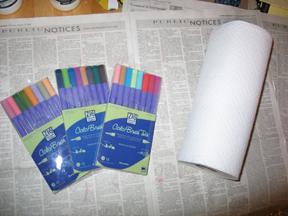
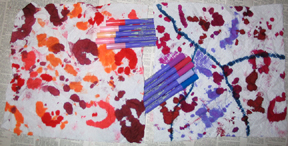
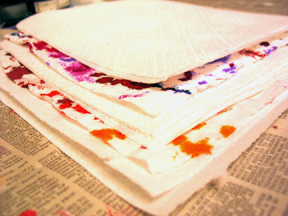
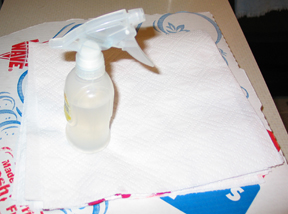
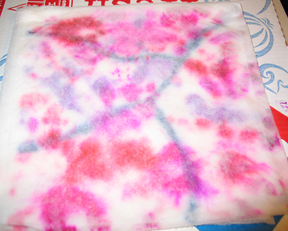
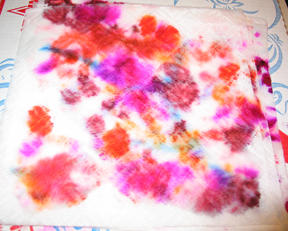
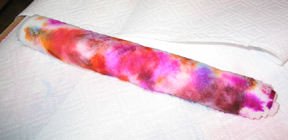
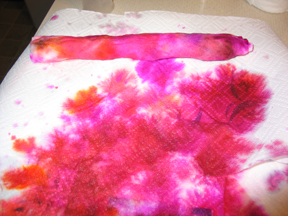
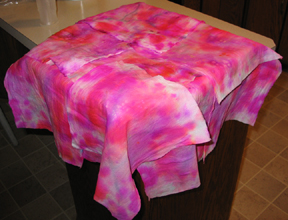
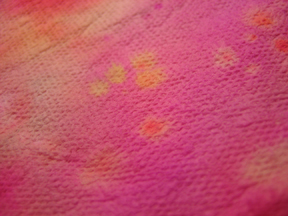
No comments:
Post a Comment